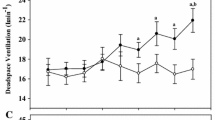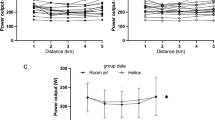Abstract
The effect of the self-contained breathing apparatus (SCBA) with compressed air (BA-A) on ventilatory mechanics, work of breathing (WOB), pulmonary function, and respiratory muscle fatigue, was compared with that of a low resistance breathing valve (LRV). Further, the effect of unloading the respiratory muscles with heliox with the SCBA (BA-H) was compared with BA-A and LRV. Twelve men completed three randomized exercise trials on separate days, each consisting of three 10 min bouts of stepping exercise (Bouts 1, 2, and 3) separated by a 5 min recovery. Subjects wore firefighter protective equipment including the SCBA. At rest, FEV1 and peak expiratory flow rates were lower with BA-A than with LRV, but were higher with BA-H than either with BA-A or LRV. After Bout 3, expiratory reserve volume, expiratory resistive WOB, and inspiratory elastic WOB were increased in BA-A compared to LRV but these were lower with BA-H compared to BA-A. After Bout 3, maximal inspiratory and expiratory pressures were reduced with BA-A, but not with LRV or BA-H. In summary, we found that the SCBA reduced resting pulmonary function, and increased expiratory reserve volume, work of breathing, and respiratory muscle fatigue during stepping exercise, and these changes can be reduced with the use of heliox.





Similar content being viewed by others
References
Aliverti A, Iandelli I, Duranti R, Cala SJ, Kayser B, Kelly S, Misuri G, Pedotti A, Scano G, Sliwinski P, Yan S, Macklem PT (2002) Respiratory muscle dynamics and control during exercise with externally imposed expiratory flow limitation. J Appl Physiol 92:1953–1963
American Thoracic Society (1995) Standardization of spirometry. Am J Respir Crit Care Med 152:1107–1136
Babb TG (2001) Breathing He–O2 increases ventilation but does not decrease work of breathing during exercise. Am J Respir Crit Care Med 163:1128–1134
Babb TG (2002) Hyperventilation with He–O2 breathing is not decreased by superimposed external resistance. Respir Physiol Neurobiol 133:139–151
Babcock MA, Pegelow DF, McClaran SR, Suman OE, Dempsey JA (1995) Contribution of diaphragmatic power output to exercise-induced diaphragm fatigue. J Appl Physiol 78:1710–1719
Black LF, Hyatt RE (1969) Maximal respiratory pressures: normal values and relationship to age and sex. Am Rev Respir Dis 99:696–702
Butcher SJ, Jones RL, Eves ND, Petersen SR (2006) Work of breathing is increased during exercise with the self-contained breathing apparatus regulator. Appl Physiol Nutr Metab 31:693–701
Bygrave S, Legg SJ, Myers S, Llewellyn M (2004) Effect of backpack fit on lung function. Ergonomics 26:324–329
Coates AL, Desmond KJ, Demizio D, Allen P, Beaudry PH (1988) Sources of error in flow–volume curves: effect of expired volume measured at the mouth vs that measured in a body plethysmograph. Chest 94:976–982
Crapo RO, Morris AH, Gardner RM (1981) Reference spirometric values using techniques and equipment that meet ATS recommendations. Am Rev Respir Dis 123:659–664
Dreger RW, Jones RL, Petersen SR (2006) Effects of the self-contained breathing apparatus and fire protective clothing on maximal oxygen uptake. Ergonomics 49:911–920
Eves ND, Petersen SR, Jones RL (2002) Hyperoxia improves maximal exercise with the self-contained breathing apparatus (SCBA). Ergonomics 45:829–839
Eves ND, Petersen SR, Jones RL (2003a) Effects of helium and 40% O2 on graded exercise with self-contained breathing apparatus. Can J Appl Physiol 28:910–926
Eves ND, Petersen SR, Jones RL (2003b) Submaximal exercise with a self-contained breathing apparatus: the effects of hyperoxia and inspired gas density. Aviat Space Environ Med 74:1040–1047
Eves ND, Jones RL, Petersen SR (2005) The influence of self-contained breathing apparatus (SCBA) on ventilatory function and maximal exercise. Can J Appl Physiol 30:507–519
Eves ND, Petersen SR, Haykowsky MJ, Wong EY, Jones RL (2006) Helium-hyperoxia, exercise and respiratory mechanics in chronic obstructive pulmonary disease. Am J Respir Crit Care Med 174:763–771
Hayashi K, Honda Y, Ogawa T, Kondo N, Nishiyau T (2006) Relationship between ventilatory response and body temperature during prolonged submaximal exercise. J Appl Physiol 100:414–420
Johnson BD, Aaron EA, Babcock MA, Dempsey JA (1996) Respiratory muscle fatigue during exercise: implications for performance. Med Sci Sports Exerc 28:1129–1137
Johnson BD, Weisman IM, Zeballos RJ, Beck KC (1999) Emerging concepts in the evaluation of ventilatory limitation during exercise: the exercise tidal flow–volume loop. Chest 116:488–503
Lambert RK (1986) Analysis of bronchial mechanics and density dependence of maximal expiratory flow. J Appl Physiol 61:138–149
McClaran SR, Wetter TJ, Pegelow DF, Dempsey JA (1999) Role of expiratory flow limitation in determining lung volumes and ventilation during exercise. J Appl Physiol 86:1357–1366
Melissant CF, Lammers JWJ, Demedts M (1998) Relationship between external resistances, lung function changes and maximal exercise capacity. Eur Respir J 11:1369–1375
Milic-Emili J, Mead J, Turner JM (1964) Topography of esophageal pressure as a function of posture in man. J Appl Physiol 19:212–216
O’Donnell DE, Revill SM, Webb KA (2001) Dynamic hyperinflation and exercise intolerance in chronic obstructive pulmonary disease. Am J Respir Crit Care Med 164:770–777
Palange P, Valli G, Onorati P, Antonucci R, Paoletti P, Rosato A, Manfredi F, Serra P (2004) Effect of heliox on lung dynamic hyperinflation, dyspnea, and exercise endurance capacity in COPD patients. J Appl Physiol 97:1637–1642
Pellegrino R, Brusasco V, Rodarte JR, Babb TG (1993) Expiratory flow limitation and regulation of end-expiratory lung volume during exercise. J Appl Physiol 4:2552–2558
Roussos C, Campbell EJM (1986) Respiratory muscle energetics. In: Handbook of physiology. The respiratory system. Mechanics of breathing. Am Physiol Soc, Bethesda, MD, sect 3, vol 3, pt 2, chap 28, pp 481–509
Schilder DP, Roberts A, Fry DL (1963) Effect of gas density and viscosity on the maximal expiratory flow–volume relationship. J Clin Invest 42:1705–1713
Sliwinski P, Yan S, Gauthier AP, Macklem PT (1996) Influence of global inspiratory muscle fatigue on breathing during exercise. J Appl Physiol 80:1270–1278
Stubbing DG, Pengelly LD, Morse JC, Jones NL (1980) Pulmonary mechanics during exercise in normal males. J Appl Physiol 49:506–510
Wang LY, Cerny FJ (2004) Ventilatory response to exercise in simulated obesity by chest loading. Med Sci Sports Exerc 36:780–786
West JB (2005) Respiratory physiology: the essentials, 7th edn. Lippincott Williams and Wilkins, Philadelphia
Wilson GD, Welch HG (1980) Effects of varying concentrations of N2/O2 and He/O2 on exercise tolerance in man. Med Sci Sports Exerc 12:380–384
Yan S, Kayser B, Tobiasz M, Sliwinski P (1996) Comparison of static and dynamic intrinsic positive end-expiratory pressure using the Campbell diagram. Am J Respir Crit Care Med 154:938–944
Acknowledgments
Support for this work was provided by the Canadian Forces Fire Marshall, Department of National Defence.
Author information
Authors and Affiliations
Corresponding author
Rights and permissions
About this article
Cite this article
Butcher, S.J., Jones, R.L., Mayne, J.R. et al. Impaired exercise ventilatory mechanics with the self-contained breathing apparatus are improved with heliox. Eur J Appl Physiol 101, 659–669 (2007). https://doi.org/10.1007/s00421-007-0541-5
Accepted:
Published:
Issue Date:
DOI: https://doi.org/10.1007/s00421-007-0541-5




